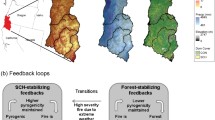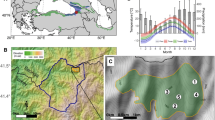Abstract
We added certain aspects of species-specific phenology, and of local frost regimes to a standard invididual-based patch model of forest stand dynamics, which we used to explore the possible consequences of four climate-change scenarios in eight distinct forest regions in British Columbia, Canada. According to model projections, lowland temperate coastal forests will be severely stressed because forest tree species will no longer have their winter-chilling requirements met. High-elevation coastal forests may either remain stable or decrease in productivity, while interior subalpine forests may eventually resemble those now found in the coastal mountains. Southern interior forests are likely to persist relatively unchanged, while boreal and sub-boreal forests of the northern interior may become dominated by Douglas-fir and western larch, rather than by spruce and pine as at present. The rate of change in forest composition may be very high in some cases. Changes under the four climate-change scenarios generally vary in magnitude but not in direction. This exercise illustrates that different forest types might respond to a changing climate for different reasons, and at different rates.
Similar content being viewed by others
References
Botkin, D. B., Janak, J. F, and Wallis, J. R.: 1972, ‘Rationale, Limitations and Assumptions of a Northeastern Forest Growth Simulator’, IBM J. Res. Develop. 16, 101–116.
Burton, P. J. and Cumming, S. G.: 1995, ‘Potential Effects of Climatic Change on Some Western Canadian Forests, Based on Phenological Enhancements to a Patch Model of Forest Succession’, Water, Air, and Soil Pollut. 82, 401–414.
Cannell, M. G. R. and Smith, R. I.: 1986, ‘Climatic Warming, Spring Budburst and Frost Damage on Trees’, J. Appl. Ecol. 23, 177–191.
Cumming, S. G. and Burton, P. J.: 1993, ‘A Programmable Shell and Graphics System for Forest Stand Simulation’, Environ. Software 8, 219–230.
Cumming, S. G. and Burton, P. J.: 1994, ‘Zelig++ v0.9 Documentation, User Notes and Installation Guide’, Technical report, Department of Forest Sciences, University of British Columbia, Available by anonymous ftp from grebe.geog.ubc.ca in pub/Zelig++/doc.ps.Z.
Fuchigami, I. H., Weiser, C. J., Kobayashi, K., Timmis, R., and Gusta, I. V.: 1982, ‘A Degree Growth Stage (∘GS) Model and Cold Acclimation in Temperate Woody Plants’, in Li, P. H. and Sakai, A. (eds.), Plant Cold Hardiness and Freezing Stress, Vol. 2, Academic Press, New York, pp. 93–116.
Huettl, R. F. and Mueller-Dombois, D. (eds.): Forest Decline in the Atlantic and Pacific Region, Springer, Berlin.
Lauenroth, W. K.: 1996, ‘Application of Patch Models to Examine Regional Sensitivity to Climate Change’, Clim. Change 34, 155–160 (this issue).
Lavender, D. P.: 1991, ‘Measuring Phenology and Dormancy’, in Lassoie, J. P. and Hinkley, T. M. (eds.), Techniques and Methodologies in Tree Ecophysiology, CRC Press, Boca Raton, FL, pp. 403–422.
Pojar, J., Klinka, K., and Meidinger, D. V.: 1987, ‘Biogeoclimatic Ecosystem Classification in British Columbia’, For. Ecol. Manage. 22, 119–154.
Sakai, A. and Okada, S.: 1971, ‘Freezing Resistance of Conifers’, Silvae Genet 20, 91–97.
Sakai, A. and Wesier, C. J.: 1973, ‘Freezing Resistance of Trees in North America with Reference to Tree Regions’, Ecology 54, 118–126.
Shugart, H. H. and Smith, T. M.: 1996, ‘A Review of Forest Patch Models and Their Application to Global Change Research’, Clim. Change 34, 131–153 (this issue).
Urban, D. L., Harmon, M. R., and Halpern, C. B.: 1993, ‘Potential Response of Pacific Northwestern Forests to Climatic Change, Effects of Stand Age and Initial Composition’, Clim. Change 23, 247–266.
Worrall, J.: 1983, ‘Temperature-budburst Relationships in Amabilis and Subalpine Fir Provenance Tests Replicated at Different Elevations’, Silvae Genet. 32, 203–209.
Author information
Authors and Affiliations
Rights and permissions
About this article
Cite this article
Cumming, S.G., Burton, P.J. Phenology-mediated effects of climatic change on some simulated British Columbia forests. Climatic Change 34, 213–222 (1996). https://doi.org/10.1007/BF00224632
Received:
Revised:
Issue Date:
DOI: https://doi.org/10.1007/BF00224632




